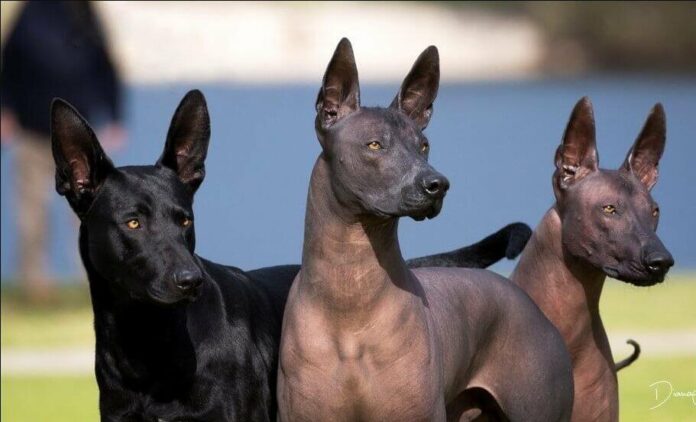Last Updated on October 7, 2023 by Fumipets
Top 4 Egyptian Dog Breeds (With Pictures)
Egyptian dog breeds have a rich history that dates back thousands of years. These breeds were revered in ancient Egypt for their roles in hunting, guarding, and companionship. Today, Egyptian dog breeds continue to capture the hearts of dog lovers worldwide. Here are some notable Egyptian dog breeds:
-
Pharaoh Hound: Known for their elegant appearance and speed, Pharaoh Hounds are one of the oldest domesticated dog breeds. They are intelligent, loyal, and make excellent family pets.
-
Saluki: Often referred to as the “Royal Dog of Egypt,” Salukis are graceful and athletic hounds. They were historically used for hunting and have a calm and gentle demeanor.
-
Canaan Dog: Though not exclusive to Egypt, the Canaan Dog has roots in the ancient Middle East, including Egypt. These dogs are highly intelligent, loyal, and make excellent working dogs.
-
Basenji: Originating from Central Africa, Basenjis were also kept as hunting dogs in ancient Egypt. They are known for their unique yodel-like bark and independent nature.
-
Ibizan Hound: While not originally from Egypt, Ibizan Hounds have ancient origins and share similarities with Egyptian hounds. They are agile and make loving family companions.
Egyptian Dog Breeds
Some of the oldest dog breeds in the world may be found in Egypt. One of the first civilizations to domesticate dogs was ancient Egypt. A artwork of a man walking a dog on a leash may be found in a tomb that dates as far back as 3500 B.C., proving that dogs had been present in Egypt long before then.
Given the conditions in which they were bred, many Egyptian dog breeds have smooth, short hair.
Top 4 Egyptian Dog Breeds
1. Saluki

One of the oldest canine breeds in existence and the one most closely associated with Egypt is the Saluki. Once, nomadic tribes would employ this sighthound to track out game animals. Most likely, they were initially raised in the Fertile Crescent, but the Egyptians eventually refined them into the contemporary breed that we are familiar with today.
The Saluki is regarded to be quicker over long distances, whereas the Greyhound is the quickest dog over short distances. They are capable of maintaining a speed of up to 42.8 mph. Because of their heavily cushioned feet, which absorb stress as they run, they have exceptional stamina.
These creatures often preyed on hares, foxes, gazelles, and jackals. As a prey animal emerged, the dogs would leap off of the camels they were often kept on top of, giving them an immediate speed advantage.
Even today, the Saluki still behaves a lot like a hunting dog. While they are by no means hostile, they are hesitant towards strangers. Training them might be challenging since they can be independent. They don’t do well when left alone for extended periods of time since they become bored easily. While these dogs require some exercise, they don’t like rough play or fetch. But they do like cuddly toys.
2. Basenji

One example of a prehistoric hunting dog is the Basenji. They are well recognized for their peculiar yodeling, which is pitched higher than the “bark” of a Siberian Husky. While the Basenji is known as the “barkless” dog, they are in no way quiet. They may even be fairly loud.
These canines also exhibit other odd characteristics. For instance, they share a trait with dingoes in that they only go into heat once a year. They also hardly have any smell, which is unusual for dogs. To have a better look, they may sometimes stand on their rear legs like meerkats.
These dogs are very vigilant and inquisitive. They prefer to attach themselves tightly to one person and avoid interacting with others since they are hesitant among strangers. With their intense hunting drive, they do not get along well with non-canine pets like cats. They dislike moist conditions as well, and many will do everything it takes to get away from water.
Despite their high intelligence, they often exploit it for their personal benefit, such as to get food. They do well throughout training but are often too autonomous and distant.
3. Baladi

Technically, this dog isn’t really a breed. The Baladi is one of Egypt’s most popular breeds of dog, nonetheless. Although they are referred to as Egypt’s street dogs, they are not produced by any breeders but rather randomly reproduce as strays. As the majority of these canines have lived on the streets for decades, they often resemble one another in appearance. They have long legs, thin, pale skin, and large ears. The majority have wavy tails.
While these canines are not often adopted in Egypt, they have gained popularity there. They usually like interacting with others and rapidly adjust to living at home. They are polite and fast to pick up new instructions. Most of these dogs quickly learn how to play retrieve after never having seen a tennis ball before.
Rather of barking, they speak in a snarling tone. This may seem a little alarming at first since many people assume the dog is being hostile. That also means that the dog is quieter than others, however. They have husky-like vocalizations, although they are quieter and growlier.
4. Armant

This is a unique species with an interesting past. As they originated in Egypt, where they are currently mostly found, armants are a modern breed. They most likely originated as European dogs, however, and after making their way to Egypt, developed into their own breed. According to others, they were transported by Napoleon’s soldiers and most likely bred with indigenous breeds to create the Armant.
They are named after the town of Armant in Egypt, which is obviously where the breed originated. This breed is very uncommon, particularly outside of Egypt. They are used in Egypt as guard and herding dogs. They reportedly served as herding dogs in Napoleon’s army, which explains how they developed these qualities!
https://www.youtube.com/watch?v=may58NxCsz0
5 Questions and Answers (Q&A):
What roles did Egyptian dog breeds play in ancient Egypt?
Egyptian dog breeds served various roles, including hunting game, guarding homes and temples, and providing companionship to their owners.
Are these breeds commonly found in modern Egypt?
While some of these breeds can still be found in Egypt, they are not as prevalent as they once were. Modern urbanization and changes in lifestyle have led to a decline in their numbers.
What makes Pharaoh Hounds unique among Egyptian dog breeds?
Pharaoh Hounds are distinctive for their striking appearance, including a sleek, red coat and expressive ears. They are also known for their affectionate and playful nature.
Are these breeds suitable for families as pets?
Yes, many Egyptian dog breeds, such as the Pharaoh Hound and Saluki, can make excellent family pets. They are known for their loyalty and compatibility with children.
What should prospective owners know about these breeds?
Prospective owners should be prepared for the specific needs and characteristics of each breed. Research and understanding of their exercise requirements, temperament, and health considerations are essential for providing a loving and suitable home.


















